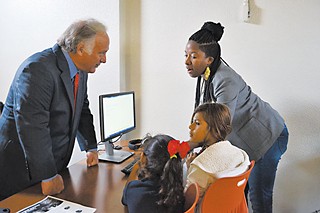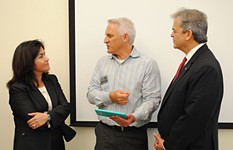Closing the Digital Divide
HACA residents offered free Google Fiber
By Mary Tuma, Fri., Nov. 28, 2014
Austin is slated to take a major leap toward bridging the city's digital divide, city and state leaders announced last Thursday afternoon. In partnership with Google Fiber, the city is offering 4,300 public housing residents living in the 18 Housing Authority of the City of Austin developments across the city a chance to join the upcoming high-speed Internet rollout for free (or at least a nominal cost) for the next decade. The broader Google Fiber rollout is expected to hit South and Southeast Austin starting in December.
Flanked by newly minted U.S. Department of Housing and Urban Development Secretary Julián Castro and state Sen. Kirk Watson, D-Austin, HACA president and CEO Michael Gerber delivered the message outside East Austin's Booker T. Washington Terraces. The plan, Gerber said, would alter the cultural fabric of Austin and help close the gap between the digital haves and have-nots.
"If you lack access to the Internet, or don't have access to a computer or tablet; or if you don't understand the Internet's relevance to your daily life, then you're even farther apart and more separated from your community and its resources," said Gerber. "All too often that separateness has been the case for residents of public housing. ... For us, the Internet is an information superhighway, but for kids and families in public housing, the Internet, at times, is more like an information bike path."
Dubbed "Unlocking the Connection," the new program, led by nonprofit Pathways Youth & Family Services and supported by a dozen business, philanthropic, and academic partners, is meant to engage traditionally underserved, low-income communities, and thus those most likely to be disconnected. African-Americans, the elderly, those earning less than $30,000, and those without a high school diploma are statistically more inclined to be left offline.
Austin public housing residents largely fit the category – the average household income for a public housing family hovers at $14,000 a year; many are elderly and most minority, per 2013-14 data from HACA. Speakers, such as Georgian Manor public housing resident Rachel Martinez, made the connection between equitable access to technology and social and economic mobility, pointing to the myriad opportunities lost when home web browsing isn't a reality – job searches, education and research, health care information, and civic participation. "My son uses a computer to work on his résumé, because if he wants a job, he has to apply online," said Martinez.
The goal is three-pronged: Aside from the Internet connection, the program will provide tech devices – Austin Community College has donated 600 pieces of computer equipment for the first year alone. Corporate sponsors are also contributing – the Ford and Open Society foundations have thus far provided $300,000. Lastly – and "arguably the most important," according to Gerber – the plan includes a digital literacy component coupled with science, technology, engineering, and mathematics (STEM) training. For instance, Google is subsidizing training at Austin Free-Net, the Eastside nonprofit dedicated to closing the digital gap.
The digital inclusion plan is said to be completely novel; never before has a city's housing authority extended this type of service to its community. Castro, who left his post as San Antonio mayor in July for HUD, shared his hope that the trailblazing Austin plan will be used as a template elsewhere. "It's clear that without broadband, folks are less likely to graduate high school, less likely to get high-paying, 21st century jobs – they start out at a disadvantage," said Castro. "So what you're doing here in Austin is a national model for what ought to happen in the United States of America for our young people."
There are potential roadblocks. First, neighborhoods (or "Fiberhoods") must meet signup goals for the service, and part of that means getting enough interested residents on board – program partners said they're geared up to rally as many community members as possible. And while Google will build the fiber optic network infrastructure for free at "serviceable" HACA properties, as well as provide home Internet connection setups and service for 10 years at no cost, residents will need to pay the $10 pre-registration fee, a possible (albeit minimal, compared to the waived $300 construction fee) barrier for low-income Austinites. And lastly, the service is not quite equivalent to the famed 1 gigabit per second provided by Google Fiber, but still speedy 5 megabits per second. (Residents can upgrade at any point – for a price.)
Overall, the plan appears to be an impressive effort to increase digital inclusion and a strategic effort by Google to bypass the problems associated with its first, 2011 Fiber rollout, in Kansas City. Surveys reflect that Google Fiber is largely being adopted by those who already have Internet access, and very rarely by the low-income and minority residents who should most benefit.
The digital inclusion strategy will be rolled out over three years, simultaneously with the larger Austin network plan. In a separate announcement by Google Fiber on Monday, the Internet giant unveiled pricing plans for its Austin services and a sneak peak of its new Downtown "Fiber Space," at 201 Colorado St. (site of the former Austin Children's Museum). The tech-equipped space, to be open in December, will serve as a meeting spot for town halls, live music, field trips, and a DIY production studio – precise date to be determined. "We aren't being coy," said Mark Strama, head of Google Fiber-Austin. "We just don't want to get it wrong."
Google Fiber by the Numbers
Basic Internet: $300 construction fee / No monthly fee / 5 Mbps download speed / 1 Mbps upload speed
Gigabit Internet: $70 per month
Gigabit Internet and TV: $130 per month / 150 HD channels
Got something to say on the subject? Send a letter to the editor.











